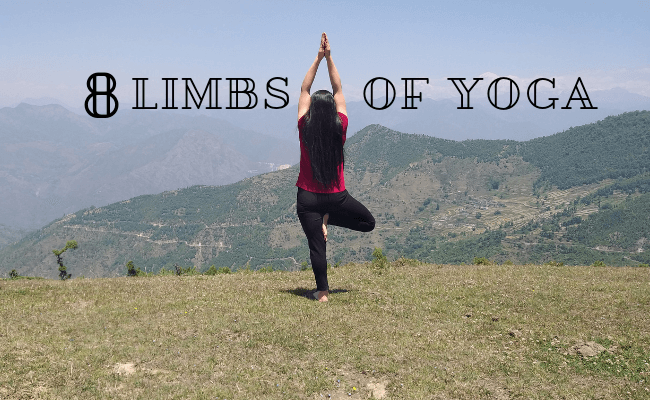
On the coronary heart of spirituality of yoga, the “8 Limbs of Yoga,” is a scientific and sensible framework launched by the sage Patanjali in his revered textual content, the Yoga Sutras.
On this complete information, we is not going to solely know what are the 8 limbs of yoga but additionally delve into the essence of every limb: the aim they serve and offer you sensible insights on find out how to incorporate them into your yoga observe.
These eight limbs kind the cornerstone of yoga philosophy, encompassing ethical, bodily, religious, and sensible points. By understanding their significance and embracing them as integral parts of your yoga journey, you’ll be able to unlock profound interior development and obtain a heightened state of consciousness.
Understanding the 8 Limbs of Yoga
Patanjali’s Yoga Sutras is a textual content of knowledge that illuminates the trail to self-realization. At its core lie the “8 Limbs of Yoga,” that are a roadmap for people in search of to deepen their reference to themselves by way of systematic observe of yoga.
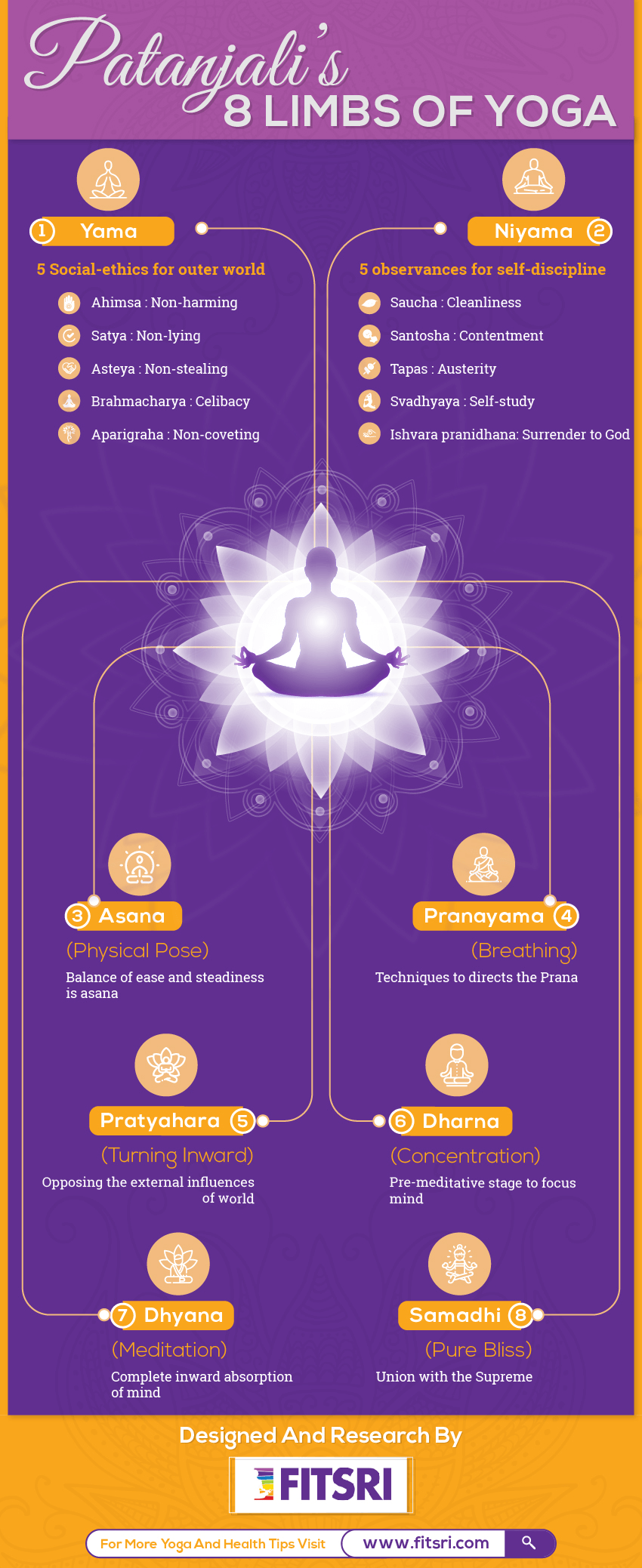
The eight limbs of yoga are Yama (Restraints), Niyama (Observances), Asana (Posture), Pranayama (Breath Management), Pratyahara (Withdrawal of the Senses), Dharana (One-pointed focus), Dhyana (Meditation), and Samadhi (Pure bliss).
Function of the 8 Limbs
- The first function of the 8 Limbs of Yoga is to steer practitioners towards Samadhi, the ultimate eighth limb, the place pure bliss and self-realization reside.
- 8 limbs function a structured strategy to dwelling a extra aware, significant, and harmonious life. Certainly they make the inspiration of a yogic life-style.
- By practising the 8 Limbs, one can transcend the restrictions of the bodily world, attaining greater states of consciousness and understanding the interconnectedness of all beings.
Tips on how to Follow the 8 Limbs?
- Every limb is a stepping stone, and whereas they’re interconnected, they can be individually cultivated.
- To observe the 8 Limbs successfully, it’s essential to combine them into your each day life.
- As we proceed by way of this information, we’ll discover every limb intimately, providing insights and sensible tips about find out how to incorporate them into your yoga journey.
Put together to embark on a transformative exploration of the 8 Limbs of Yoga. We’ll delve into the aim behind every limb and offer you actionable steps to weave them into your observe, enriching your life each on and off the mat.
Yama: The First Limb (Social Ethics)
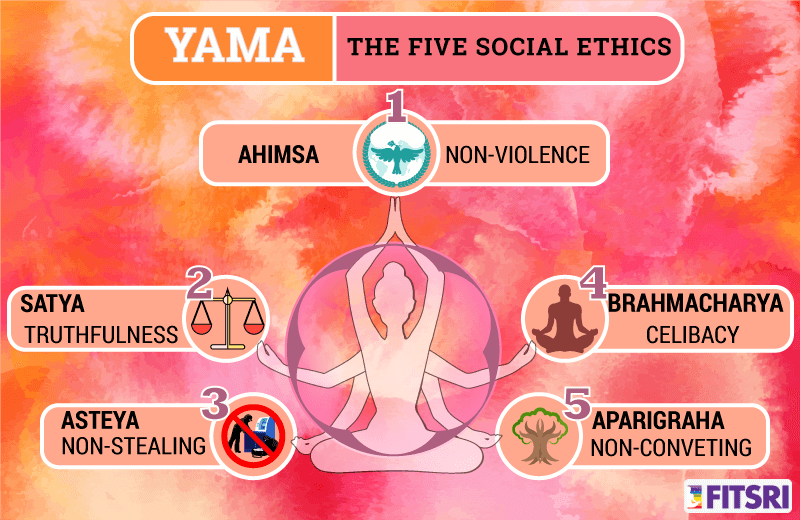
The journey by way of the 8 Limbs of Yoga begins with Yama, the primary limb that lays the inspiration for moral and ethical conduct in our lives. Yama could be seen as a set of pointers, sometimes called “social ethics,” that form our interactions with the exterior world. It encompasses a profound sense of duty towards others and the world round us.
Function of Yama
- Yama serves as an ethical compass, directing us in direction of proper conduct and harmonious relationships.
- It encourages us to domesticate qualities that promote peace, compassion, and integrity.
- The aim of Yama is to create a strong moral basis, permitting us to progress by way of the next limbs with a transparent and guilt-free conscience.
Tips on how to Follow Yama?
- Yama consists of 5 key ideas, often called the “5 Yamas,” every addressing a selected side of moral conduct.
- To observe Yama successfully, one should self-reflect and consciously apply these ideas in each day life.
- Let’s delve into every Yama to grasp their significance and discover ways to incorporate them into our interactions with the world
Be happy to discover the depths of every Yama by clicking on the above hyperlinks. Every yama information unravel its that means and sensible steering on find out how to embrace them in your each day existence. By understanding and embodying Yama, you are taking step one on the trail to self-realization and a extra compassionate manner of being.
Niyama: The Second Limb (Observances)
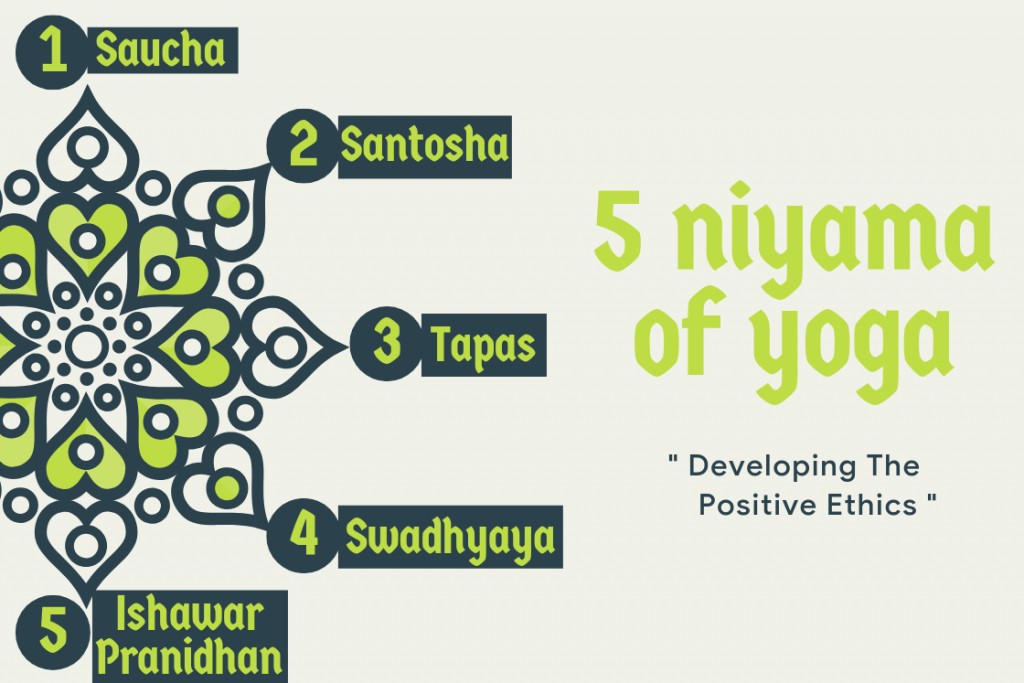
As we progress on our journey by way of the 8 Limbs of Yoga, we encounter Niyama, the second limb. Niyama represents a set of observances, providing pointers for self-discipline and private development. Simply as Yama focuses on our moral conduct in direction of the exterior world, Niyama directs our consideration inwards, shaping our relationship with ourselves.
Function of Niyama
- Niyama encourages self-purification and self-improvement, fostering a way of interior concord and stability.
- It serves as a roadmap for growing qualities like contentment, self-discipline, and self-reflection.
- The aim of Niyama is to arrange the interior panorama, making it fertile floor for the practices of the next limbs.
Tips on how to Follow Niyama?
- Niyama includes 5 important observances, every designed to nurture your interior world.
- To observe Niyama successfully, domesticate these observances as each day habits, permitting them to turn into an integral a part of your life.
- Let’s discover the 5 Niyamas in-depth, understanding their significance, and discovering how they’ll improve your interior journey:
By practising Niyama, you deepen your connection along with your interior self and thus embark on a path of self-discovery and private development.
Asana: The Third Limb (Bodily Posture)

With a strong basis in moral conduct (Yama) and self-observance (Niyama), we transfer ahead to Asana, the third limb of the 8 Limbs of Yoga. Asana interprets to “bodily posture” and is commonly the side of yoga that first involves thoughts. Nonetheless, within the context of the 8 Limbs, Asana is way more than putting spectacular poses; it’s about discovering stillness of physique and thoughts in any posture.
Function of Asana
- Asana goals to domesticate bodily energy, flexibility, and stability, making ready the physique for deeper yogic practices.
- It serves as a way to calm the thoughts by aligning breath and motion, fostering mindfulness.
- The aim of Asana is to create a wholesome and balanced bodily basis, permitting the practitioner to sit down comfortably for meditation and interior exploration.
Tips on how to Follow Asana?
- Asana includes a wide selection of bodily postures, from easy stretches to extra superior poses.
- To observe Asana successfully, it’s essential to strategy it with mindfulness, specializing in the breath and sustaining a way of ease.
- Whereas Patanjali’s Yoga Sutra mentions meditative postures, fashionable yoga contains all kinds of poses that promote bodily well-being.
Pranayama: The Fourth Limb (Respiratory Methods)

As we ascend the trail of the 8 Limbs of Yoga, we arrive at Pranayama, the fourth limb. Pranayama is the artwork of harnessing the breath, the Prana (life pressure) that flows inside and round us. It includes numerous respiration methods and workouts designed to control and develop our breath, unlocking a deeper connection between the physique and the thoughts.
Function of Pranayama
- Pranayama is a strong observe for enhancing the circulation of prana (very important vitality) inside the physique, selling bodily and psychological well-being.
- It aids in calming the thoughts, lowering stress, and making ready the practitioner for meditation.
- The aim of Pranayama is to develop breath consciousness, directing it to totally different areas of the physique, and finally, to succeed in greater states of consciousness.
Tips on how to Follow Pranayama?
- Pranayama contains quite a lot of respiration methods, from easy breath consciousness to superior practices like Ujjayi, Kapalabhati, and Nadi Shodhana.
- To observe Pranayama successfully, one should begin with primary methods and progressively progress underneath the steering of a talented instructor.
- The combination of breath management into your yoga observe enhances its transformative energy.
Pratyahara: The Fifth Limb (Turning Inward)

Pratyahara, the fifth limb of the 8 Limbs of Yoga, marks a major shift in our journey. It’s the observe of turning inward, withdrawing our senses from the exterior world and redirecting them towards our interior panorama. Pratyahara serves as a bridge, linking the exterior cleaning practices to the interior ones, making ready the thoughts for deeper exploration.
Function of Pratyahara
- Pratyahara is about gaining mastery over our senses and their fixed outward-seeking tendencies.
- It offers a gateway to silence the distractions of the exterior world, permitting us to journey deeper into meditation.
- The aim of Pratyahara is to convey consciousness inside, making a serene and centered interior atmosphere.
Tips on how to Follow Pratyahara?
- Pratyahara includes consciously withdrawing the senses from their ordinary objects of need.
- To observe Pratyahara successfully, one should domesticate mindfulness and observe the senses with out attachment or aversion.
- This observe prepares the thoughts for the superior limbs of Dharana (Focus) and Dhyana (Meditation).
By mastering Pratyahara, you create the required stillness and focus for the profound interior experiences that lie forward in your yogic journey.
Dharana: The Sixth Limb (Focus)

As we progress by way of the 8 Limbs of Yoga, we arrive at Dharana, the sixth limb. Dharana signifies the observe of focus, the place the thoughts turns into much less scattered and extra centered. It’s a pivotal step within the journey of self-realization, because it permits us to direct our consideration to a single level or object, lowering psychological distractions.
Function of Dharana
- Dharana goals to harness the wandering thoughts, bringing it underneath management and stopping it from drifting.
- It’s a preparatory stage for deeper meditation (Dhyana), as sustained focus is required to delve into the depths of consciousness.
- The aim of Dharana is to refine the thoughts’s capacity to stay nonetheless and centered.
Tips on how to Follow Dharana?
- Dharana includes focusing the thoughts on a selected object or level of consideration.
- To observe Dharana successfully, select some extent of focus, similar to a mantra, a candle flame, or the breath, and gently information your consciousness to that time.
- As distractions come up, gently convey your focus again to the chosen object.
By mastering Dharana, you develop the psychological fortitude wanted to delve deeper into the realms of meditation and self-discovery.
Dhyana: The Seventh Limb (Meditation)
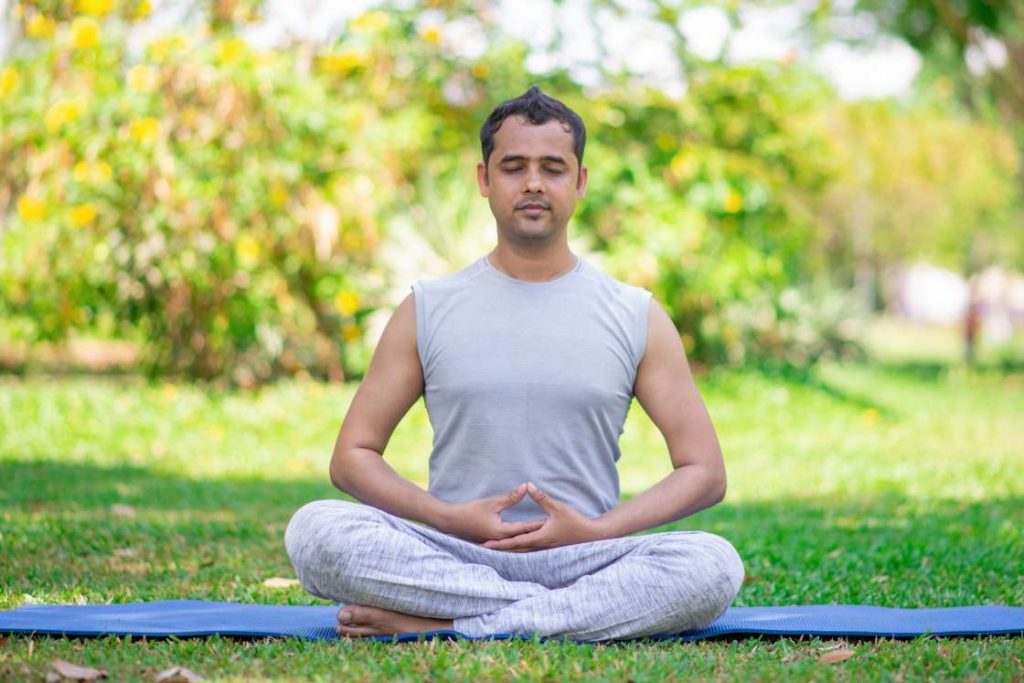
Dhyana, the seventh limb of the 8 Limbs of Yoga, represents the profound observe of meditation. After reaching mastery over focus (Dharana), we enter the state of Dhyana, the place the thoughts turns into nonetheless and totally absorbed within the object of meditation. That is the place the true exploration of the interior self begins.
Function of Dhyana
- Dhyana is the gateway to self-realization, permitting us to dive deep into the realms of consciousness and discover the true nature of our being.
- It’s a observe of interior transformation, the place the meditator transcends the ego and experiences a state of pure consciousness.
- The aim of Dhyana is to attach with the divine supply inside and attain a profound sense of peace and unity.
Tips on how to Follow Dhyana?
- Dhyana includes meditating on a selected object or mantra, sustaining a steady circulation of consciousness with out interruption.
- To observe Dhyana successfully, domesticate persistence and consistency in your meditation observe.
- It’s important to let go of expectations and judgments throughout meditation, permitting the thoughts to enter a state of pure consciousness.
By mastering Dhyana, you open the door to interior transformation and a profound connection along with your true self.
Samadhi: The Eighth Limb (Pure Bliss)
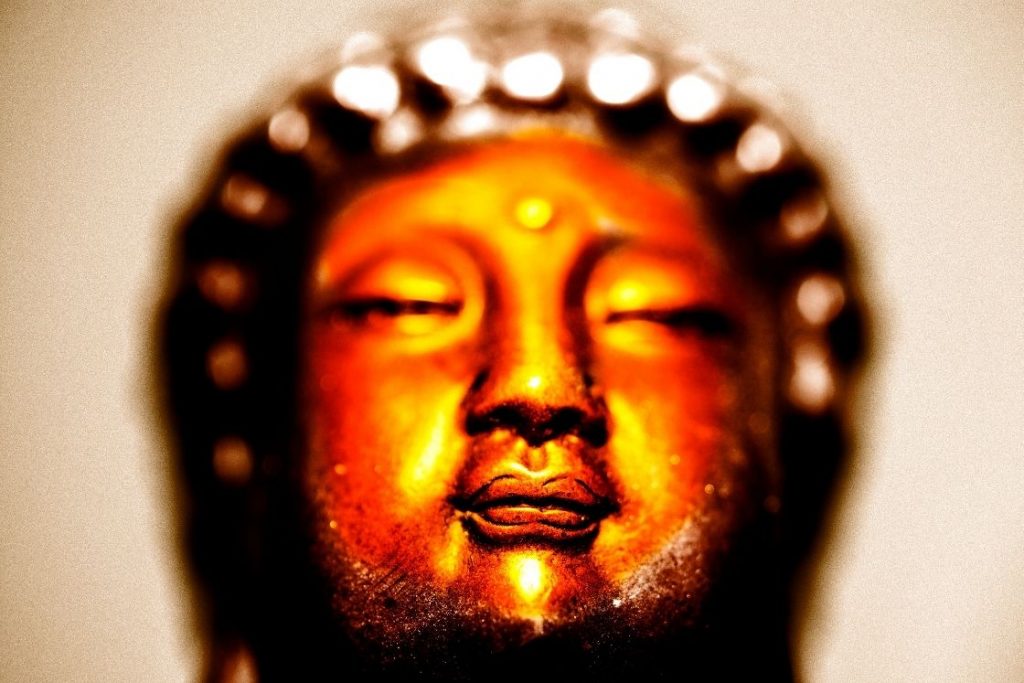
Within the journey by way of the 8 Limbs of Yoga, we attain the head: Samadhi, the eighth and ultimate limb. Samadhi represents the state of pure bliss and self-realization. It’s the end result of the yogic path, the place the practitioner merges with the common consciousness, transcending the restrictions of the person self.
Function of Samadhi
- Samadhi is the final purpose of yoga, the place the practitioner experiences a state of oneness with the universe, free from the ego’s constraints.
- It results in liberation (moksha) from the cycle of delivery and loss of life, bringing everlasting peace and contentment.
- The aim of Samadhi is to comprehend the true nature of the self and expertise a profound sense of unity, love, and bliss.
Tips on how to Attain Samadhi?
- Samadhi can’t be achieved by way of effort alone; it’s a state of grace that arises when the thoughts is pure, centered, and free from wishes.
- To domesticate the situations for Samadhi, one should diligently observe the previous limbs, together with Yama, Niyama, Asana, Pranayama, Pratyahara, Dharana, and Dhyana.
- Give up to the divine and let go of attachment to the fruits of your actions.
By aspiring towards Samadhi, you embark on a journey of self-discovery and religious awakening, transcending the boundaries of the self to expertise pure bliss and unity with the universe.
Conclusion
The 8 Limbs of Yoga, as expounded by the sage Patanjali within the Yoga Sutras, characterize a profound and complete path to self-realization, interior peace, and religious awakening. This historical system presents a roadmap for people in search of stability, function, and a deeper understanding of their true selves.
The importance of the 8 Limbs of Yoga extends far past the yoga mat. These ideas could be built-in into your each day life, guiding you in direction of a lifetime of mindfulness, compassion, and self-awareness.
Incorporate 8 limbs one step at a time, beginning with Yama and Niyama (moral ideas), progressively progressing by way of Asana (bodily postures), Pranayama (breath management), Pratyahara (turning inward), Dharana (focus), Dhyana (meditation), and finally, Samadhi (pure bliss).
FAQs Concerning the 8 Limbs of Yoga
The 8 Limbs of Yoga present a complete information to dwelling a balanced and purposeful life, resulting in self-realization and interior peace.
Whereas the limbs are historically practiced sequentially, some flexibility exists. Nonetheless, mastering every limb earlier than shifting to the subsequent is really useful for a powerful basis.
Begin by integrating Yama and Niyama (moral ideas) into your each day interactions. Regularly add Asana, Pranayama, and meditation practices. Consistency is essential.
Whereas a educated instructor or guru can present steering, self-study and self-discipline are important. Many practitioners discover mentors or lecturers useful however not obligatory.
Sure, the 8 Limbs function a foundational framework for all paths of yoga, together with Hatha, Ashtanga, Vinyasa, and others.




